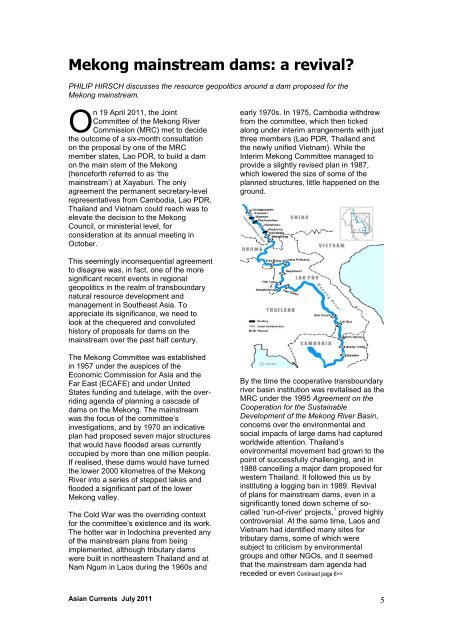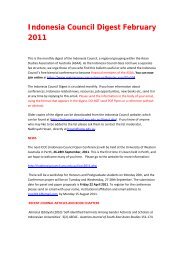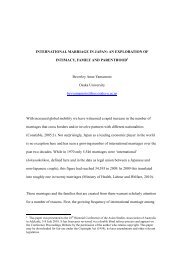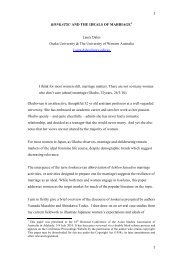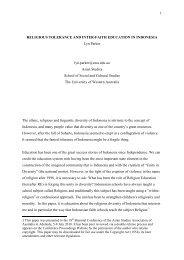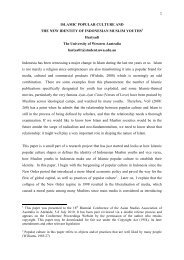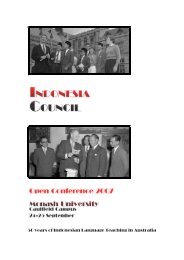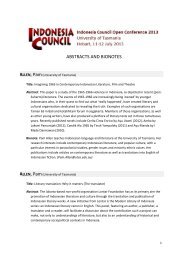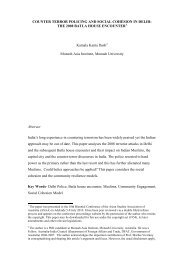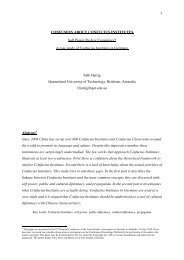Asian Currents - Asian Studies Association of Australia
Asian Currents - Asian Studies Association of Australia
Asian Currents - Asian Studies Association of Australia
You also want an ePaper? Increase the reach of your titles
YUMPU automatically turns print PDFs into web optimized ePapers that Google loves.
Mekong mainstream dams: a revival<br />
PHILIP HIRSCH discusses the resource geopolitics around a dam proposed for the<br />
Mekong mainstream.<br />
O<br />
n 19 April 2011, the Joint<br />
Committee <strong>of</strong> the Mekong River<br />
Commission (MRC) met to decide<br />
the outcome <strong>of</strong> a six-month consultation<br />
on the proposal by one <strong>of</strong> the MRC<br />
member states, Lao PDR, to build a dam<br />
on the main stem <strong>of</strong> the Mekong<br />
(henceforth referred to as ‗the<br />
mainstream‘) at Xayaburi. The only<br />
agreement the permanent secretary-level<br />
representatives from Cambodia, Lao PDR,<br />
Thailand and Vietnam could reach was to<br />
elevate the decision to the Mekong<br />
Council, or ministerial level, for<br />
consideration at its annual meeting in<br />
October.<br />
early 1970s. In 1975, Cambodia withdrew<br />
from the committee, which then ticked<br />
along under interim arrangements with just<br />
three members (Lao PDR, Thailand and<br />
the newly unified Vietnam). While the<br />
Interim Mekong Committee managed to<br />
provide a slightly revised plan in 1987,<br />
which lowered the size <strong>of</strong> some <strong>of</strong> the<br />
planned structures, little happened on the<br />
ground.<br />
This seemingly inconsequential agreement<br />
to disagree was, in fact, one <strong>of</strong> the more<br />
significant recent events in regional<br />
geopolitics in the realm <strong>of</strong> transboundary<br />
natural resource development and<br />
management in Southeast Asia. To<br />
appreciate its significance, we need to<br />
look at the chequered and convoluted<br />
history <strong>of</strong> proposals for dams on the<br />
mainstream over the past half century.<br />
The Mekong Committee was established<br />
in 1957 under the auspices <strong>of</strong> the<br />
Economic Commission for Asia and the<br />
Far East (ECAFE) and under United<br />
States funding and tutelage, with the overriding<br />
agenda <strong>of</strong> planning a cascade <strong>of</strong><br />
dams on the Mekong. The mainstream<br />
was the focus <strong>of</strong> the committee‘s<br />
investigations, and by 1970 an indicative<br />
plan had proposed seven major structures<br />
that would have flooded areas currently<br />
occupied by more than one million people.<br />
If realised, these dams would have turned<br />
the lower 2000 kilometres <strong>of</strong> the Mekong<br />
River into a series <strong>of</strong> stepped lakes and<br />
flooded a significant part <strong>of</strong> the lower<br />
Mekong valley.<br />
The Cold War was the overriding context<br />
for the committee‘s existence and its work.<br />
The hotter war in Indochina prevented any<br />
<strong>of</strong> the mainstream plans from being<br />
implemented, although tributary dams<br />
were built in northeastern Thailand and at<br />
Nam Ngum in Laos during the 1960s and<br />
By the time the cooperative transboundary<br />
river basin institution was revitalised as the<br />
MRC under the 1995 Agreement on the<br />
Cooperation for the Sustainable<br />
Development <strong>of</strong> the Mekong River Basin,<br />
concerns over the environmental and<br />
social impacts <strong>of</strong> large dams had captured<br />
worldwide attention. Thailand‘s<br />
environmental movement had grown to the<br />
point <strong>of</strong> successfully challenging, and in<br />
1988 cancelling a major dam proposed for<br />
western Thailand. It followed this us by<br />
instituting a logging ban in 1989. Revival<br />
<strong>of</strong> plans for mainstream dams, even in a<br />
significantly toned down scheme <strong>of</strong> socalled<br />
‗run-<strong>of</strong>-river‘ projects, 1 proved highly<br />
controversial. At the same time, Laos and<br />
Vietnam had identified many sites for<br />
tributary dams, some <strong>of</strong> which were<br />
subject to criticism by environmental<br />
groups and other NGOs, and it seemed<br />
that the mainstream dam agenda had<br />
receded or even Continued page 6>><br />
<strong>Asian</strong> <strong>Currents</strong> July 2011 5


